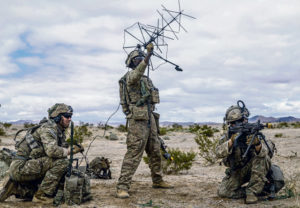
ABERDEEN PROVING GROUND, Md. — Army Futures Command is developing next-generation satellite communications capabilities through the use of innovative partnerships known as cooperative research and development agreements.
The Army uses SATCOM capabilities to provide beyond line-of-sight (BLOS) communications that allow Soldiers to maintain consistent communications in all environments and situations, even when there is great distance between military personnel, or the terrain is dense.
The Command, Control, Communications, Computers, Cyber, Intelligence, Surveillance and Reconnaissance (C5ISR) Center — a component of AFC’s Combat Capabilities Development Command — is using SATCOM-centric CRADAs with multiple industry partners to learn how the Army’s tactical network can enhance BLOS capabilities through current and emerging commercial satellite constellations, explained Rich Hoffmann, an electronics engineer within the C5ISR Center.
The Army relies heavily on geosynchronous-earth orbit satellites, which are fixed in the sky and easy to track. Yet the high orbit distance delays communications and requires significant power when transmitting data from the ground to the satellite. Incorporating other satellite constellations — such as low-earth orbit and mid-earth orbit — with their different ranges and capabilities, allows the Army to obtain the resiliency and diversity it needs to ensure consistent beyond-line-of-sight communications in a variety of battlefield environments, according to Hoffmann, who said the ability to communicate over long distances can be the key to winning on the tactical battlefield.
“Our resilient satellite communication capabilities also enable other key technologies, such as long-range precision fires,” Hoffmann said. “Reliably connecting the sensor to the shooter, even when the enemy is trying to take your long range links down with jamming, is essential.”
Enhancing the resiliency of the Army’s network is a vital component of Capability Set 23 — a collection of network capability enhancements informed by experimentation, demonstration, and direct Soldier feedback, scheduled to be fielded in 2023.
“We’re looking at what the Army is going to deploy years from now. We’re leveraging future military satellites, but to get the throughput and the resilience required, we’re looking to add diversity to the architecture. We can’t afford to develop multiple military systems, so we’re going to leverage commercial SATCOM systems. First, we need learn about the specifics of the systems to understand how they could fit into the Army’s network architecture, and there’s where the CRADAs come in,” Hoffmann said.
Hoffmann noted that military communications requirements are very different than typical commercial communications, so engineers aren’t always certain whether an emerging commercial system will work for the military; thus, the ability to freely share information with potential vendors is essential.
In a CRADA, the Army provides personnel, facilities, equipment or other resources, with or without reimbursement, to identify and develop technologies to meet the government’s needs. While the exact details of the Army-industry relationship vary according to the specific agreement, this mutually beneficial relationship allows the Army to gain greater awareness of industry technologies and examine how it can help solve capability gaps. The agreements also provide clauses that the government will protect all information the vendor discloses.
In return, industry learns military-specific requirements, such as the ability for technology to withstand rugged environments not typically seen for commercial products. CRADAs also allow the government to share real threat data with industry partners, who can then adapt their technologies to meet and defeat anticipated threats. Finally, industry is also able to work side-by-side with Army engineers who can provide insight to what will work for the Soldier in the battlefield.
The C5ISR Center currently has 5 active SATCOM CRADAs and more than 100 active CRADAs across all of its mission areas, according to Hoffmann, who noted these partnerships shorten the timeline from identifying a capability gap to developing solutions.
“There are a lot of technologies that are really out of the box, that are really game changers. So now more than ever, we’re really excited to be working with these companies and understanding their technologies because they’re bringing a tremendous amount of capability for the battlefield,” he said.
The C5ISR SATCOM-related CRADAs are focusing on resiliency and diversity, explained Martin Ortiz, a C5ISR Center electronics engineer who oversees the Center’s CRADAs. “We get resiliency and diversity through the use of the different constellations: low-earth orbit, medium-earth orbit, and geosynchronous-earth orbit. Each one has a different potential,” he added.
Many of the technologies being developed under the C5ISR Center’s current CRADAs were tested at the Network Modernization Experiment (NetModX) 2020, allowing the Army to test and better understand the potential of emerging commercial satellite constellations and technologies, and how they can potentially be incorporated into the Soldier’s communications toolbox. New SATCOM technologies will also be tested at Project Convergence 2021.
“The best thing about the CRADAs […] is the relationships that form. These can be relationships that last for years and are so useful when looking at a new technology or looking at new projects,” said Ortiz.
In addition to industry, CRADAs can be formed with private and non-profit corporations (U.S. or foreign), state and local governments, and other federal agencies.
For more information about CRADAs and how to partner with the Center, please visit the C5ISR Business Opportunities website.


